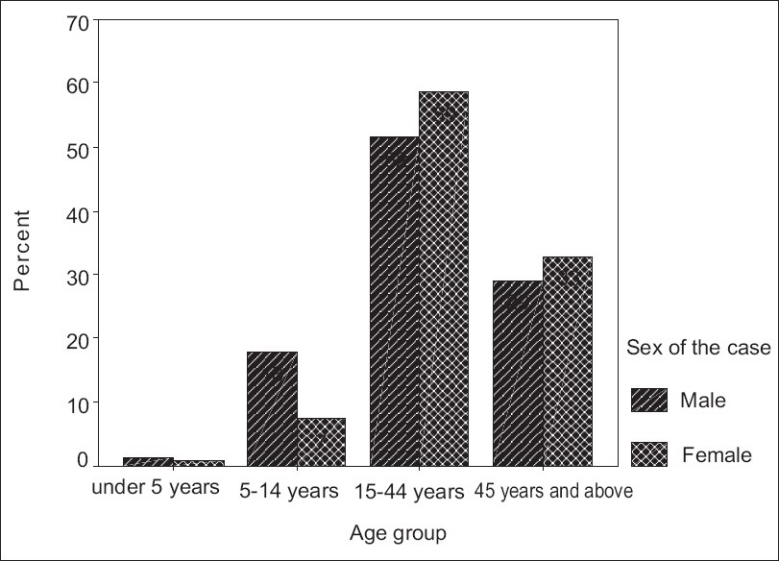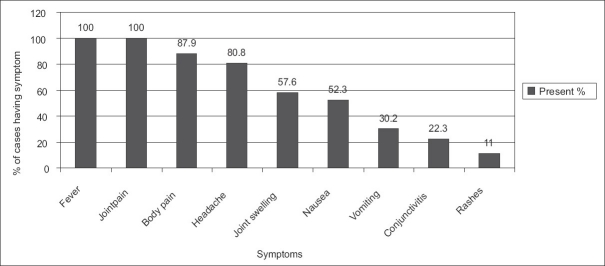Abstract
Background:
The outbreak of Chikungunya in India started during December 2005 with more than 11,00,000 cases. Many cases with symptoms suggestive of Chikungunya reported to our urban health-training centre. Hence this study was done to estimate the prevalence of Chikungunya, to study the common treatment-seeking behavior, control measures and the sequalae of Chikungunya by follow-up.
Materials and Methods:
This cross-sectional study was done in Anagaputhur an urban field practice area of our college. The study was done on a sample selected by systematic random sampling. Any person with fever and joint pain, with an onset from 1 August 2006 to 31 August 2006, were enrolled as cases. The cases were followed up after three months.
Results:
Chikungunya prevalence in the community was 22.3%; 52% of them were females and 56% of cases were in the 15-44 years age group. Median duration of acute phase was three days. Ninety-one percent of them had multiple joints’ involvement. Seventy-eight percent sought treatment from the private sector. Sixty-seven percent reported artificial collections of water around their household and 44% complained of mosquito problems during the day. Eighty-eight percent used mosquito repellents for personal protection. On follow-up 95% of them had residual joint pain, 43% had residual joint swelling and 11% had disabilities with median duration of 30 days.
Conclusions:
Prevalence of Chikungunya was 22.3%, predominantly affecting the age group of 15-44 years and females. The private sector was commonly sought for treatment. Entomological survey indicated Aedes breeding. Eleven percent had disabilities due to the sequelae.
Keywords: Chikungunya, health-seeking behavior, prevalence, sequelae
Introduction
Chikungunya is an arthropod-borne viral infection resembling dengue caused by Group IV RNA arbo virus and transmitted by the Aedes aegypti mosquito, which presents with symptoms of fever and joint pain. Though mortality is rare with this disease morbidity and temporary disability do occur in larger proportions due to residual joint pain. The last reported epidemic of Chikungunya in India was in 1963-64(1) with an outbreak in Chennai in 1964.(2,3) An outbreak in India started during December 2005 and the country has so far experienced more than 11,00,000 Chikungunya-infected cases.(4–6) This fever epidemic was reported in Tamil Nadu in all districts except the districts of Nilgiris and Tiruvanamalai.(7) This fever epidemic was serologically proved to be Chikungunya by analysis carried out at National Institute of Virology (NIV), Pune. Many cases with symptoms similar to Chikungunya were reported to the urban health-training centre at Anagaputhur which created an opportunity to know the prevalence and overall clinical picture of the disease. As a laboratory diagnosis of every case was not feasible, this survey was based on a syndromic approach. The cases however could be linked epidemiologically to the confirmed cases of Chikungunya fever.
Objectives
To estimate the prevalence of Chikungunya during the month of August 2006 in our field practice area by a syndromic approach
To study the sequelae of Chikungunya in the population by following them up.
To study the common treatment-seeking behavior and control measures in the community.
Materials and Methods
This cross-sectional study was done in Anagaputhur (near Chennai), an urban field practice area of our college. The survey was done by groups of pre-final medical students with a pre-tested questionnaire in 317 houses covering 1589 population. The first house was selected with the last digit of a randomly picked up rupee note and every 10th house was surveyed starting from that house. Any person with fever and joint pain with onset from 1 August 2006 to 31 August 2006 was enrolled as a case of Chikungunya fever. Details on the socio-economic class, number of members living in that family, symptoms, place of treatment, mosquito nuisance and protection methods adopted were collected from the respondent. The cases were followed up after three months to study the sequelae of the disease. The Department of Public Health carried out an entomological survey. The collected data were analyzed using SPSS Version 10.0.
Results
A total of 317 out of 2349 houses and 369 out of 2690 families and 1589 out of 13454 persons spread out in 81 streets were surveyed; 354 cases were identified. Hence the prevalence was calculated to be 22.3%.
44.9% of the persons affected belonged to socio-economic Class 3 while 3.1% belonged to socio-economic Class 5 as per modified Kuppusamy's classification.
Of the affected cases, 42.7% were males and 57.3% were females;
Maximum of 55.6% were in the age group of 15-44 years, while only 1.1% percent cases were below 5 years of age [Figure 1]. Of the cases who reported fever, onset was acute in 89.3% of cases and insidious in the remaining 10.7%. However, 225 out of the 354 cases had high-grade and continuous fever (63.6%) with acute onset.
Multiple joints were involved in 91.8% of cases. Joint swelling was present in 57.6% of cases and 58.2% of cases suffered from disability [Figure 2].
Median duration for fever was three days and for joint pain was four days in the acute phase.
77.7% of the affected persons sought treatment from private clinics and 18.4% took treatment from the Government health setup.
66.9% of cases reported artificial water collection near their houses while the remaining 33.1% were not aware of any such water collection.
43.8% complained of mosquito menace during daytime and 87.3% during night-time.
88.4% of cases used mosquito repellents, 8.2% used bed net and 8.2% used window screens as individual protection methods.
While 21.2% said that fogging operations were carried out by the municipality only 2.3% mentioned anti-larval spraying.
-
Entomological observations revealed the following information:
No. of streets observed: 19
No. of houses checked: 705
No. of houses positive for breeding: 98
No. of containers checked: 892
No of containers positive for larvae: 120
House index: 17.0
Container index: 8.08
Breteau Index: 17.0
Barrels, mud pots, flowerpots, grinding stones and sumps were common sources of breeding [Table 1].
Figure 1.

Age sex distribution of cases in percentage
Figure 2.
Symptoms of chikungunya fever percentage of cases
Table 1.
Breeding sources of Aedes mosquito in the surveyed area

Since patients who had suffered from Chikungunya were frequenting the urban health centre following Chikungunya, it was proposed to take up the sequelae study after an interval of three months. One hundred and sixty-six (47%) cases out of the 354 patients recruited initially could be followed up. Ninety-five percent of the followed patients had residual joint pain for a median duration of 30 days; 43% of the patients followed up had residual joint swelling for a median duration of 30 days. Eleven percent of them had disabilities like inability to move the hand (7%) or inability to walk (4%) for a median duration of 30 days.
Discussion
This study was done in the urban field practice area of a private medical college, Chennai. There are 2690 families living in 2349 houses in that field area and it was decided to cover 10% of the houses by systematic random sampling. However, the data were covered actually from 317 houses (13.5%). A higher percentage of houses than the 10% of the sample were studied because the houses are located in 81 streets and sampling was done street-wise. The affected persons had other concomitant symptoms of body pain, headache, joint swelling, nausea, vomiting, conjunctivitis and rash. Such concomitant symptoms among Chikungunya cases have been recorded in the news bulletin of centres for disease control, United States of America(8) and by Saxena et al.(9)
The age group of 15–44 years was mostly affected (about 55%). Children were least affected. This is similar to the outbreak in Reunion reported by Cordel et al.(10) However, in the study conducted by Sharma et al., during the outbreak in Madras city in 1964 it was found that the population belonging to the age group 5–9 years had the highest percentage of morbidity (23.2%). The lowest percentage of morbidity was reported among infants (8.9%).(3) The sex ratio in this area is 1079 females per 1000 males; however, more females were affected in this locality probably due to the fact that females continued to be present in their houses than males. This has been reflected earlier by Saxena et al.(9) However, in the study conducted by Sharma et al., it has been reported that the males were more frequently affected than females.(3)
The average duration of fever was reported to be about four days in the report by Sharma et al., and Thirvengadam et al.,(3,11) whereas in this study the median duration of fever is three days. Vector indices were calculated and it revealed that house index was 17.0, container index was 8.08 and breteau Index was 17.0. These indices are high when compared to the entomological indices laid down for assessing the same vector for Dengue fever/ Dengue Hemorraghic Fever, since no such indices are available for Chikungunya fever. After a gap of three months the study of the sequalae due to Chikungunya fever revealed that 11% of the patients suffered due to disabilities following Chikungunya fever.
Conclusions
Chikungunya prevalence in this community was 22.3%, predominantly affecting the 15-44 year age group and females.
The fever is acute in onset, high-grade and continuous.
The median duration of fever was three days and joint pain was four days.
Multiple joints’ involvement and disabilities due to joint pain were common in the people affected.
The private sector was commonly approached for treatment.
Artificial collection of water and mosquito problems during daytime suggested Aedes breeding.
Mosquito repellents were the commonest control measure used for individual protection against the mosquitoes. Anti-adult measures were undertaken in certain pockets.
Residual joint pain (95%) and residual joint swelling (43%) were common sequelae and 11% of them had disabilities due to the sequelae. The median duration of the sequelae and disabilities was 30 days.
Acknowledgments
Our sincere thanks to our Dean Dr. Kamal Sheriff for giving us permission to undertake this study. Our heartfelt thanks to the Department of Public Health and Preventive Medicine, Tamil Nadu, especially to Mr. Md. Abdullah and Mr. Sudalaimani, Senior Entomologists, for the entomological studies. Sincere thanks to the field staff of the urban health training centre and other students of MBBS for their kind cooperation and team effort in collecting the data.
Footnotes
Source of Support: Nil
Conflict of Interest: None declared.
References
- 1.Shah KV, Gibbs CJ, Jr, Banerjee G. Virological investigation of the epidemic of haemorrhagic fever in Calcutta: Isolation of three strains of chikungunya virus. Indian J Med Res. 1964;52:676–83. [PubMed] [Google Scholar]
- 2.Dandawate CN, Thiruvengadam KV, Kalyanasundaram V, Rajagopal J, Rao TR. Serological survey in Madras city with special reference to Chikungunya. Indian J Med Res. 1965;53:707–14. [PubMed] [Google Scholar]
- 3.Sharma HM, Shanmugam CA, Iyer SP, Rao AR, Kuppuswami SA. Report on a random survey conducted to assess the prevalence of a Dengue like illness in Madras city- 1964. Indian J Med Res. 1965;53:720–8. [PubMed] [Google Scholar]
- 4.Chikungunya. [Last accessed on 2010 Dec 07]. Available from: http://www.en.wikipedia.org/wiki/Chikungunya: Wikipedia .
- 5.Mishra B, Ratho RK. Chikungunya re-emergence: Possible mechanisms. Lancet. 2006;368:918. doi: 10.1016/S0140-6736(06)69370-7. [DOI] [PubMed] [Google Scholar]
- 6.Outbreak news. Chikungunya and dengue, south-west Indian Ocean. Wkly Epidemiol Rec. 2006;81:106–8. [PubMed] [Google Scholar]
- 7.Oral presentation- Elango s. Joint director of Public health and Preventive Medicine O/O DPHandPM, Anna Salai, Chennai-600006
- 8. [Last accessed on 2010 Dec 07]. Available from: http://www.cdc.gov/travel/other/2006/chikungunya_india.htm .
- 9.Saxena SK, Singh M, Mishra N, Lakshmi V. Resurgence of chikungunya virus in India: An emerging threat. Euro Surveill. 2006;11:E060810. doi: 10.2807/esw.11.32.03019-en. [DOI] [PubMed] [Google Scholar]
- 10.Cordel H. Investigation Group. Chikungunya outbreak on Réunion: Update. Euro Surveill. 2006;11:E060302.3. doi: 10.2807/esw.11.09.02912-en. [DOI] [PubMed] [Google Scholar]
- 11.Thiruvengadam KV, Kalyanasundaram V, Rajgopal J. Clinical and pathological studies on chikungunya fever in Madras city. Indian J Med Res. 1965;53:729–44. [PubMed] [Google Scholar]



